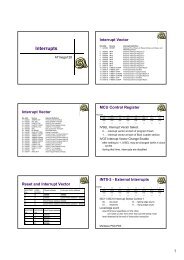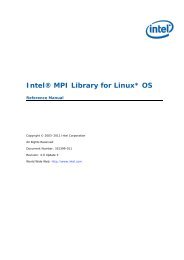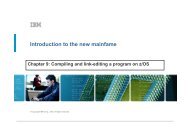Introduction to the new mainfame Chapter 7: Designing and ...
Introduction to the new mainfame Chapter 7: Designing and ...
Introduction to the new mainfame Chapter 7: Designing and ...
Create successful ePaper yourself
Turn your PDF publications into a flip-book with our unique Google optimized e-Paper software.
<strong>Introduction</strong> <strong>to</strong> <strong>the</strong> <strong>new</strong> <strong>mainfame</strong><br />
<strong>Chapter</strong> 7: <strong>Designing</strong> <strong>and</strong> developing applications<br />
for z/OS<br />
© Copyright IBM Corp., 2005. All rights reserved.
<strong>Introduction</strong> <strong>to</strong> <strong>the</strong> <strong>new</strong> mainframe<br />
<strong>Chapter</strong> 7 objectives<br />
Be able <strong>to</strong>:<br />
Describe <strong>the</strong> roles of <strong>the</strong><br />
application designer <strong>and</strong><br />
application programmer.<br />
List <strong>the</strong> phases of <strong>the</strong><br />
application development life<br />
cycle.<br />
Briefly describe <strong>the</strong> process for<br />
testing a <strong>new</strong> application on z/OS.<br />
Describe <strong>the</strong> advantages <strong>and</strong><br />
disadvantages of using batch<br />
versus online for an application.<br />
List three reasons for using z/OS<br />
as <strong>the</strong> host for a <strong>new</strong> application.<br />
© Copyright IBM Corp., 2005. All rights reserved.
<strong>Introduction</strong> <strong>to</strong> <strong>the</strong> <strong>new</strong> mainframe<br />
Key terms in this chapter<br />
application<br />
architecture<br />
database<br />
design<br />
develop<br />
enablement<br />
executable<br />
infrastructure<br />
platform<br />
requirement<br />
transaction<br />
unit test<br />
© Copyright IBM Corp., 2005. All rights reserved.
<strong>Introduction</strong> <strong>to</strong> <strong>the</strong> <strong>new</strong> mainframe<br />
What is an application<br />
An application<br />
• A piece of software that will satisfy certain specific requirements<br />
or resolve certain problems<br />
• The solution can reside on any platform or combination of<br />
platforms<br />
© Copyright IBM Corp., 2005. All rights reserved.
<strong>Introduction</strong> <strong>to</strong> <strong>the</strong> <strong>new</strong> mainframe<br />
Who designs applications for <strong>the</strong> mainframe<br />
Application designer:<br />
Determines <strong>the</strong> best programming solution for an important business<br />
requirement.<br />
Underst<strong>and</strong>s:<br />
• Business objectives of <strong>the</strong> company<br />
• O<strong>the</strong>r roles in <strong>the</strong> mainframe IT organization<br />
• Company’s hardware <strong>and</strong> software.<br />
Has a global view of <strong>the</strong> entire project.<br />
© Copyright IBM Corp., 2005. All rights reserved.
<strong>Introduction</strong> <strong>to</strong> <strong>the</strong> <strong>new</strong> mainframe<br />
Who writes applications for <strong>the</strong> mainframe<br />
Application programmer:<br />
Builds, tests, <strong>and</strong> delivers <strong>the</strong> applications that run on <strong>the</strong><br />
mainframe for end users<br />
Works from <strong>the</strong> application designer’s specifications<br />
Uses a variety of <strong>to</strong>ols<br />
Application programming involves many iterations of:<br />
Code changes <strong>and</strong> compiles<br />
Application builds<br />
Unit testing.<br />
© Copyright IBM Corp., 2005. All rights reserved.
<strong>Introduction</strong> <strong>to</strong> <strong>the</strong> <strong>new</strong> mainframe<br />
Where applications reside<br />
Internet Enterprise Network Central Site<br />
Web<br />
Server<br />
Browser<br />
Appl.<br />
Server<br />
e-business<br />
Browser<br />
e-business<br />
with Legacy Systems<br />
Web<br />
Server<br />
Browser<br />
Appl.<br />
Server<br />
Business Systems<br />
Databases<br />
Browser<br />
Server<br />
Business<br />
Systems<br />
Applications<br />
Client-Server<br />
Personal<br />
Computer<br />
GUI Front-End<br />
Term inal<br />
Processing<br />
Personal<br />
Computer<br />
Business<br />
Systems<br />
Front End<br />
"Dumb" Terminal<br />
© Copyright IBM Corp., 2005. All rights reserved.
<strong>Introduction</strong> <strong>to</strong> <strong>the</strong> <strong>new</strong> mainframe<br />
Application development lifecycle<br />
Ga<strong>the</strong>r<br />
requirements<br />
Analysis<br />
Design<br />
Code & test<br />
User, System<br />
tests<br />
Go<br />
production<br />
Maintenance<br />
© Copyright IBM Corp., 2005. All rights reserved.
<strong>Introduction</strong> <strong>to</strong> <strong>the</strong> <strong>new</strong> mainframe<br />
Ga<strong>the</strong>ring requirements for <strong>the</strong> design<br />
Requirements:<br />
• Assess what needs <strong>to</strong> be accomplished<br />
• Based on projects constraints<br />
• Always keep in mind <strong>the</strong> end result<br />
• Conduct interviews with users <strong>and</strong> stakeholders<br />
• Verify our assumptions<br />
© Copyright IBM Corp., 2005. All rights reserved.
<strong>Introduction</strong> <strong>to</strong> <strong>the</strong> <strong>new</strong> mainframe<br />
Types of requirements<br />
Accessibility<br />
Client<br />
Interoperability<br />
Recoverability<br />
Serviceability<br />
Availability<br />
Connectivity<br />
Performance<br />
Resource can be<br />
moni<strong>to</strong>red, controlled,<br />
managed, <strong>and</strong><br />
administered<br />
Usability<br />
Frequency of data backup<br />
Distributed<br />
Portability<br />
Secure centralized<br />
controllable capacity<br />
Web services<br />
Changeability<br />
Inter-communicable<br />
Preventing failure <strong>and</strong> fault<br />
analysis<br />
© Copyright IBM Corp., 2005. All rights reserved.
<strong>Introduction</strong> <strong>to</strong> <strong>the</strong> <strong>new</strong> mainframe<br />
Design phase<br />
Users<br />
Constraints<br />
Verify<br />
Verify<br />
Requirements<br />
Analysis<br />
Design<br />
Design<br />
documents<br />
Business<br />
Technical<br />
Revise<br />
Revise<br />
© Copyright IBM Corp., 2005. All rights reserved.
<strong>Introduction</strong> <strong>to</strong> <strong>the</strong> <strong>new</strong> mainframe<br />
Design decisions – based on requirements<br />
Batch versus online<br />
Database, tape, flat file, etc.<br />
COBOL, PL/I, JAVA, Assembler<br />
z/OS, Unix, Linux, Windows<br />
Capacity of server<br />
Server type<br />
Develop or purchase package or both<br />
© Copyright IBM Corp., 2005. All rights reserved.
<strong>Introduction</strong> <strong>to</strong> <strong>the</strong> <strong>new</strong> mainframe<br />
Development phase<br />
Design<br />
documents<br />
Coding<br />
Testing<br />
Revise<br />
Tested<br />
programs<br />
© Copyright IBM Corp., 2005. All rights reserved.
<strong>Introduction</strong> <strong>to</strong> <strong>the</strong> <strong>new</strong> mainframe<br />
Developing an application for <strong>the</strong> mainframe<br />
Programmer uses as input <strong>the</strong> specifications of <strong>the</strong><br />
designer<br />
Usually follows this process:<br />
• Code a module.<br />
• Test a module for functionality.<br />
• Make corrections <strong>to</strong> <strong>the</strong> module.<br />
• Repeat from step 2 until successful.<br />
© Copyright IBM Corp., 2005. All rights reserved.
<strong>Introduction</strong> <strong>to</strong> <strong>the</strong> <strong>new</strong> mainframe<br />
Programming <strong>to</strong>ols for <strong>the</strong> mainframe<br />
• Edi<strong>to</strong>r<br />
• TSO or ISPF-based<br />
• Reposi<strong>to</strong>ry for source code<br />
• PDS, SCLM or some o<strong>the</strong>r reposi<strong>to</strong>ry<br />
• Job moni<strong>to</strong>ring <strong>and</strong> viewing software<br />
• SDSF or equivalent product<br />
• Debugging <strong>to</strong>ols<br />
© Copyright IBM Corp., 2005. All rights reserved.
<strong>Introduction</strong> <strong>to</strong> <strong>the</strong> <strong>new</strong> mainframe<br />
Debugging a program on <strong>the</strong> mainframe<br />
• Log on <strong>to</strong> TSO<br />
• Enter ISPF – check out source code<br />
• Edit source <strong>and</strong> make modifications<br />
• Submit compile JCL <strong>to</strong> verify syntax<br />
• Switch <strong>to</strong> SDSF <strong>to</strong> view job status<br />
• View job output in SDSF – check for errors<br />
• Correct errors<br />
• Repeat from “Submit” until errors are corrected<br />
• Save source code in reposi<strong>to</strong>ry<br />
© Copyright IBM Corp., 2005. All rights reserved.
<strong>Introduction</strong> <strong>to</strong> <strong>the</strong> <strong>new</strong> mainframe<br />
Interactive Development Environment (IDE)<br />
IDEs accelerate development process<br />
• Edit source on work station<br />
• Run compiles off-platform<br />
• Perform remote debugging<br />
• Useful for “hybrid” applications<br />
• Host-based COBOL with CICS, IMS, <strong>and</strong> Web browser-like<br />
interface<br />
• Provides unified development environment <strong>to</strong> build OLTP in HLL<br />
<strong>and</strong> HTML front-end interface<br />
© Copyright IBM Corp., 2005. All rights reserved.
Test phase<br />
Tested<br />
programs<br />
User<br />
Performance<br />
Validate<br />
Test<br />
results<br />
Final<br />
tested<br />
programs<br />
Integration<br />
tests<br />
Test data<br />
Prod<br />
data<br />
O<strong>the</strong>r<br />
systems
<strong>Introduction</strong> <strong>to</strong> <strong>the</strong> <strong>new</strong> mainframe<br />
Test phases (continued)<br />
Many levels of testing<br />
• User testing for functionality, acceptance<br />
• Performance (stress) testing<br />
• Integration testing (with o<strong>the</strong>r systems)<br />
Validate <strong>the</strong> testing results<br />
Final step before going production<br />
© Copyright IBM Corp., 2005. All rights reserved.
Production phase<br />
Final<br />
tested<br />
programs<br />
Promote<br />
To<br />
production<br />
Production<br />
Reposi<strong>to</strong>ry
<strong>Introduction</strong> <strong>to</strong> <strong>the</strong> <strong>new</strong> mainframe<br />
Go production<br />
Document:<br />
• Operational procedures<br />
• Training manuals (users, administra<strong>to</strong>rs, etc.)<br />
Promote application <strong>to</strong> production status<br />
• Implement change control process<br />
H<strong>and</strong> over <strong>to</strong> operations<br />
© Copyright IBM Corp., 2005. All rights reserved.
<strong>Introduction</strong> <strong>to</strong> <strong>the</strong> <strong>new</strong> mainframe<br />
Maintenance phase<br />
Ongoing day-<strong>to</strong>-day changes/enhancements<br />
Responsibility for maintenance may change <strong>to</strong> ano<strong>the</strong>r<br />
group or stay with developers<br />
© Copyright IBM Corp., 2005. All rights reserved.
<strong>Introduction</strong> <strong>to</strong> <strong>the</strong> <strong>new</strong> mainframe<br />
Maintaining <strong>and</strong> enhancing existing systems<br />
Maintenance <strong>and</strong> enhancement is a primary role of<br />
HLL programmers on <strong>the</strong> mainframe<br />
Large corporations continue <strong>to</strong> use COBOL <strong>and</strong><br />
o<strong>the</strong>r traditional languages for <strong>new</strong> development:<br />
• Existing applications are in HLLs such as COBOL <strong>and</strong><br />
PL/I<br />
• New applications are in JAVA, COBOL <strong>and</strong> PL/I COBOL,<br />
PL/I continue <strong>to</strong> be enhanced <strong>to</strong> exploit <strong>new</strong><br />
technologies <strong>and</strong> <strong>new</strong> data formats<br />
© Copyright IBM Corp., 2005. All rights reserved.
<strong>Introduction</strong> <strong>to</strong> <strong>the</strong> <strong>new</strong> mainframe<br />
Summary<br />
<strong>Designing</strong> <strong>and</strong> developing an application for <strong>the</strong> mainframe is<br />
similar <strong>to</strong> o<strong>the</strong>r platforms, but some of <strong>the</strong> questions <strong>and</strong><br />
conclusions are different.<br />
Life cycle of designing <strong>and</strong> developing an application <strong>to</strong> run<br />
on z/OS includes phases of:<br />
• Requirements ga<strong>the</strong>ring <strong>and</strong> analysis<br />
• Design<br />
• Development<br />
• Test <strong>and</strong> debugging<br />
• Production<br />
• Maintenance<br />
© Copyright IBM Corp., 2005. All rights reserved.







